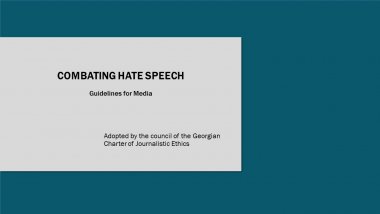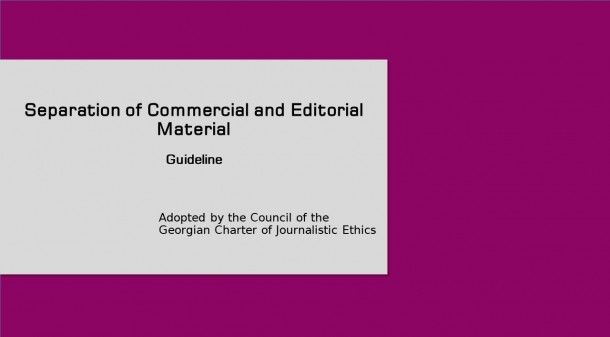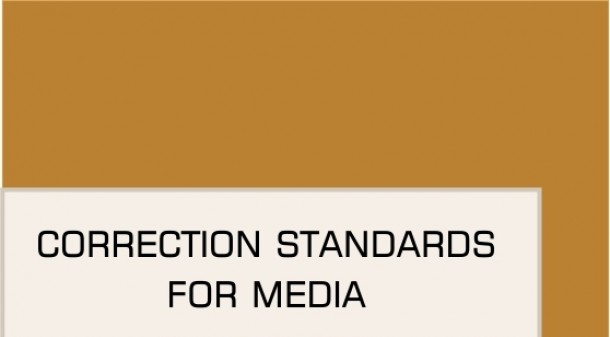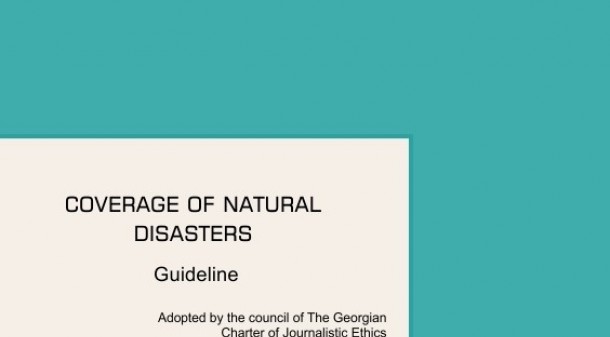According to the Charter Council practice of cases, the seventh principle covers discrimination, hate speech and stigmatization. Based on European Council and Charter definitions, hate speech should be about a certain identity. Discrimination and stigmatization should also touch on a certain characteristic and negatively show people based on this characteristic. Council said in one of the decisions that “hate speech should be aimed at a specific group and be offensive, but not every type of offensive text is a hate speech”. This way Charter Council differentiated discrimination and discreditation from each other.
The important thing about hate speech and discrimination is the context, attitude in the society about a specific topic. One thing can cause the stigma in one society to increase when members of other society might not even notice it.
If media is not careful about every case and does not think about frame and terminology used while working on sensitive topic, it might easily become a weapon to encourage and strengthen stereotypes.
General Principles
- Media companies should try not to support non-tolerant, discriminating environment and hate.
- Media has a social responsibility to not only not discriminate, but also work against irrational fears and disgust of the society.
- Each media company should have a policy of fighting against hate, which will be clear for the employees and the audience.
- Media companies need to react immediately to the feedback from citizens if the feedback says that media has been sharing hate speech or discrimination.
- Media product based on facts, in which a journalist tries to see the problem from every perspective, protects the media from encouraging discrimination.
Focusing on Identity
As was mentioned above, hate speech is directed towards groups unified with a certain identity. One negative behavior from a group member is generalized on the whole group and causes their discrimination. Every person is individually responsible for the antisocial behavior and focusing on the person’s identity you are just strengthening negative attitudes of your audience towards the whole group.
- When you decide to mention a person’s origin, religion, sexual orientation or social status in connection to the negative behavior of a person, think about how important it is for the story. Does it give additional information? Is it giving more worth to the story? Will it focus on negativity towards the whole group? If there is any risk that this information will support stigmatization and stereotypes and also if there is no lack of information caused by not adding the information, consider not focusing your attention on this detail.
- It is unacceptable to mention ethnicity, religion or another identity of the accused person if it is not directly connected to the crime in question.
- Negatively focusing on origin, religion, sexual orientation, physical characteristics or social status of a person is recommended only in the case where such information is important. For example, when a person was attacked because of discrimination or became a subject of violence because of such (religion, origin, faith, etc.) characteristics. When in the case of antisocial behavior, you think such information is important, it’s better to specify a country of origin and not an ethnicity. For example, say “Georgian government was contacted about extraditing a citizen of Iran” and not “Georgian government was contacted about extraditing an Iranian person”.
- It should be a priority of ethical media companies to fight against negative myths about people of certain identities.
- Try to check what the negative beliefs are in the society about specific identities and what they are based on.
Using Hate Speech
There is a discussion between media professionals and in general society, whether people using hate speech should be covered or not. There is no prohibition against this because there are situations when this supports discussion in the audience. We cannot share information with our audience about a large-scale fascistic or homophobic demonstration or about people who were elected in Parliament and are using hate speech from this platform. Therefore, everything is dependent on context, the reasons, and aims of coverage and its frame. Hate speech can be shared when you want to show:
- A parliament member or a public figure igniting hate and using incorrect terminology;
- A public institution being discriminatory. E.g. they have a text, warning of any kind published;
- The certain group is igniting hate in the society;
- This list is not comprehensive and can include many other topics. The main idea is that there should be a public interest present, so you have a reason for sharing the information.
- Be clear about the reason for publishing. Show that you are against such a position. This does not necessarily mean saying “We are against the ideas of the respondent”. This can be shown in a different way and with different text.
- When deciding to show a public person or institution in e.g. homophobia or other discrimination, it is best to title story with “An official used the homophobic phrase; “Minister responds to the opponent with sexist phrases”; “An institution established discriminatory restraints”, etc. If you only use the phrase as a title and hint in the text that you are against such phrases, a part of your audience might not even open the article and just by reading the title they will not guess that the editorial staff is against the decision.
Choosing Respondents
- • Choose respondents carefully. Think before giving the platform to people who are often discriminatory. Ask yourself, why are you inviting them? What is the information you are awaiting from them? Are we ready, not to support them in presenting hate speech from our platform?
- Choose respondents and the frame so that you don’t have to question any fundamental rights. For example, don’t ask questions such as “Should LGBTQ people have freedom of expression?”, “Should people of other ethnicities have a right to buy property in Georgia?” Remember that people are equal, in spite of the differences between them. Inviting respondents who want to negate those rights and use hate speech cannot be explained by balancing views. Balance is only formal in this case and causes negative attitudes to escalate.
- If you invite people who will probably use hate speech, prepare for opposing them. Think about how to stop their discrimination, how to explain to the audience that these attitudes are unacceptable towards other groups.
- It is expected that users of hate speech will provide facts that you are unable to check at that point. Therefore, try to watch their previous speeches, see what arguments they have, prepare counter questions and do not let them to deviate from the topic.
Comments of respondents
- The journalist is responsible to choose the respondent and to choose their speeches’ part. Therefore, it is important to analyze what results will follow the phrase and whether it will cause discrimination or not.
- Before using the phrase in your material, evaluate its author, their influence, type of platform they use and how they will influence the audience, whether they will support stigmas and stereotypes.
- When publishing public space recordings with audio check whether it is sharing hate speech unintentionally.
- Edit the quote of the respondent so that you do not have to support hate speech. The exception is when the material is about the usage of hate speech, for example by a public figure.
Live Coverage
When working in live transmission, respondent might use hate speech unexpectedly and it cannot be edited. In this case journalist should:
- Ask the respondent to not use discriminatory and hate speech phrases;
- Mention that it is unacceptable for the editorial group to use hate speech and discriminate against the certain group and they do not stand with the respondent;
- Stop talking to the respondent if they continue using such phrases.
- Do not let respondents use hate speech and discrimination. For this, it is necessary that at every moment journalist is commenting on what type of demonstration is going on. The audience needs to get information about the leaders of the demonstration.
- A journalist should describe the demonstration so that it is clear that the editorial group does not stand with these messages.
- If it is possible, record the comments of discriminatory people’s opponents and show them to the audience during the live. The recordings should include the counter-arguments, ideas on why hate speech is unacceptable. This will make live more balanced.
- Be careful when describing the participants of the demonstration. Try to use descriptions that are based on facts and can be proven. In there are phrases that are against LGBTQ community, you can call the demonstrating people homophobes. If there is discrimination against other nations, call them xenophobic. It should be clear to the audience why the demonstrators are homophobes, xenophobes, fascist or ultra-nationalistic.
Social Media and Comments
Often, we have cases when covering sensitive issues that there are comments on social media pages using hate speech. Real people and trolls and bots are commenting together, which faces a new challenge for media.
According to Charter practice, media company is responsible for every material and comment on their platform. Most of the media companies, though, do not have the resource to assign one person for comment control and moderation, which needs to be acknowledged when assessing media companies for efforts to fight against hate speech. It is important that media uses every resource for their platform not to be used for hate speech. For this, they should:
- Try to have moderation on comments on the webpages, the ability to delete hate speech comments or restrict commenting function.
- If you are publishing an article that might cause comments with hate speech to appear or if you notice that your comment feed is used for hate speech and you cannot regulate it, it’s better to turn to comment off. This will not be considered as a restriction of freedom of expression, because hate speech is not protected with the same standard as other forms of expression. Mention, that discriminatory and hate speech using comments will be deleted by administration. This will warn the audience that it is unacceptable to use such language and they will not be surprised if the comment is deleted. If they are on your platform, they should follow your rules.
Visualization
- Videos, photos, data are important parts for storytelling. But without context this information can be an object of interpretation and manipulation. Therefore, visual material should tell the whole story and not only one part of it.
- Pay attention to data. Only numbers, with no labels can cause audience to form incorrect perceptions.
Questions that journalists should ask themselves:
- Is there public interest about this news?
- Who uses hate speech and with what aims? Are they supported by facts?
- Does the respondent have evidence to support their claims?
- Will we avoid strengthening stereotypes and stigma through publishing this? Did we ask every relevant question?
- Is there a variety of respondents present and do the representatives of the groups talk themselves?
- Did we choose correct language for telling this story?
- Is the coverage in accordance with ethical standards?
References:
- DW Akademie - Reporting hate speech – practical tips for journalists
- Ethical Journalism Network - Hate speech A 5 point test for journalists
- #MediaAgainstHate - Guidelines for countering online hate speech






